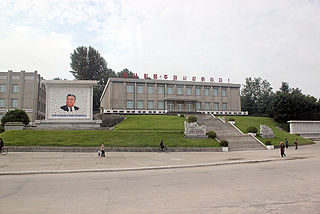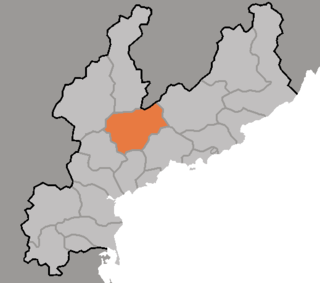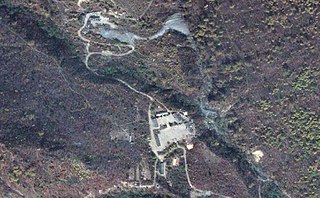
North Hamgyong Province is the northernmost province of North Korea. The province was formed in 1896 from the northern half of the former Hamgyong Province.

The Tonghae Satellite Launching Ground(동해위성발사장), also known as Musudan-ri (Korean: 무수단리), is a rocket launching site in North Korea.

Onsŏng County is a county (kun) in North Hamgyong Province, North Korea, located near the border with China. The administrative center is the town (ŭp) of Onsong. Onsong is the alleged site of the former Onsong concentration camp, now closed.

Hwadae County (Korean: 화대군) is a county in southern North Hamgyong province, North Korea, with an area of about 460 km2 and a population of approximately 70,000. It adjoins the Sea of Japan on the east and south. By land, it adjoins Kimchaek and Kilchu to the west, and Myŏngch'ŏn to the north. The county was formed from parts of Kilchu and Myŏngch'ŏn in the 1950s, as part of a general reorganization of local government. Administratively, Hwadae is divided into one ŭp and 20 ri.

Musan County is a county in central North Hamgyong province, North Korea. It borders the People's Republic of China to the north, across the Tumen River. It is divided into one ŭp, six labor districts, and fifteen ri. The county seat is the town of Musan, Musan ŭp. Luguo and Dehua are the closest Chinese cities across the river.

Kyŏngsŏng County is a kun, or county, on the central coast of North Hamgyong, North Korea. The administrative center is located in Kyŏngsŏng-ŭp.

Myŏngch'ŏn County is a kun, or county, in North Hamgyong province, North Korea. The county is home to numerous hot springs.

Yŏnsa County is a kun, or county, in North Hamgyŏng province, North Korea. It was created following the division of Korea, being split off from Musan county in the 1952 reorganization of local government.

Chŏngp'yŏng County is a county in South Hamgyŏng province, North Korea. It borders South P'yŏngan province to the south, and the East Korea Bay to the east.

Kŭmya County is a county in South Hamgyŏng province, North Korea. It borders the Sea of Japan to the east.

Sinhŭng County is a mountainous county in South Hamgyŏng province, North Korea.

Anbyŏn is a kun, or county, in Kangwŏn province, North Korea. Originally included in South Hamgyŏng province, it was transferred to Kangwŏn province in a September 1946 reshuffling of local government.

Kimhyŏnggwŏn County is a kun, or county, in southeastern Ryanggang province, North Korea. It borders South Hamgyŏng to the south. Previously known as Pungsan, it was renamed by Kim Il Sung in 1990. He named it after his uncle, Kim Hyŏng-gwŏn. It is known for its striking scenery and for the Pungsan Dog, a large breed of hunting dog.

Rangrim County is a kun, or county, on the eastern flank of Chagang province, North Korea. It was created in 1952 from portions of Changgang and Changjin, as part of a general reorganization of local government. Originally part of South Hamgyong, it was transferred to Chagang province in 1954. It borders Hwapyong and Ryanggang's Kimjongsuk and Kimhyongjik counties to the north, South Hamgyong's Pujon county to the east and Changjin to the south, as well as the counties of Changgang, Songgan, and Ryongnim to the west.
Hwasong concentration camp is a labor camp in North Korea for political prisoners. The official name is Kwan-li-so No. 16.
Mantapsan is a mountain in the south of North Hamgyong Province in North Korea. The granite peak, which reaches an elevation of 2,205 m (7,234 ft), is part of the Hamgyong Mountains. It is located on the border between Kilju County, Myŏnggan County and Orang County.

Punggye-ri Nuclear Test Site was the only known nuclear test site of North Korea. Nuclear tests were conducted at the site in October 2006, May 2009, February 2013, January 2016, September 2016, and September 2017.

P'unggye-ri is a village located in Kilju County, North Hamgyong Province, North Korea. The Punggye Station serves the village. The Punggye-ri Nuclear Test Site is located nearby.
P'unggye station is a railway station in P'unggye-ri, Kilju county, North Hamgyŏng province, North Korea, on the Paektusan Ch'ŏngnyŏn Line of the Korean State Railway.
Hapsu station is a railway station in Paegam county, Ryanggang province, North Korea, on the Paektusan Ch'ŏngnyŏn Line of the Korean State Railway.

















